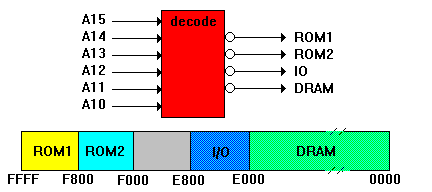The following design illustrates address decoding, which is a typical application of programmable logic devices.
Design Specification
The following figure shows the block diagram for this design and a continuous block of memory divided into four sections containing DRAM, I/O, ROM1 and ROM2. The purpose of this decoder is to monitor the six high-order bits (A15-A10) of a sixteen-bit address bus and select the correct section of memory based on the value of these address bits.

The address ranges associated with each section of memory are shown as follows. These address ranges can also be seen in the source file.


